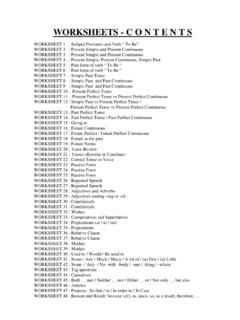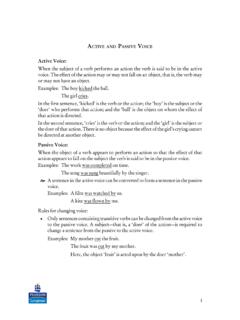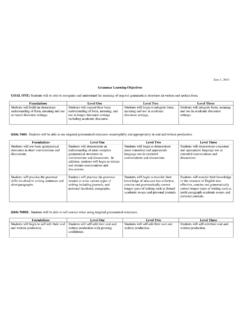Transcription of ENGLISH GRAMMAR, TENSES Tenses
1 ENGLISH GRAMMAR, TENSES Page 1 of 38 TENSES The ENGLISH Tense System The links below are to lessons for each of the 12 basic TENSES . In each lesson we look at two aspects of the tense: Structure: How do we make the tense? Use: When and why do we use the tense? Some lessons look at additional aspects, and most of them finish with a quiz to check your understanding. Present Tense I do do, I do Present continuous Tense I am doing, I am doing tomorrow Present Perfect Tense I have done Present Perfect continuous Tense I have been doing past Tense I did do, I did past continuous Tense I was doing past Perfect Tense I had done past Perfect continuous Tense I had been doing Future Tense I will do Future continuous Tense I will be doing Future Perfect Tense I will have done Future Perfect continuous Tense I will have been doing Many ENGLISH learners worry too much about tense. If you stopped 100 native ENGLISH speakers in the street and asked them about tense, one of them might give you an intelligent answer if you were lucky.
2 The other 99 would know little about terms like " past perfect" or "present continuous ". And they would know nothing about aspect, voice or mood. But they can all speak fluent ENGLISH and communicate effectively. Of course, for ESL it helps to know about TENSES , but don't become obsessed with them. Be like those native speakers! Speak naturally! PDF created with pdfFactory Pro trial version GRAMMAR, TENSES Page 2 of 38 Simple Present Tense I sing How do we make the Simple Present Tense? subject + auxiliary verb + main verb do base There are three important exceptions: 1. For positive sentences, we do not normally use the auxiliary. 2. For the 3rd person singular (he, she, it), we add s to the main verb or es to the auxiliary. 3. For the verb to be, we do not use an auxiliary, even for questions and negatives. Look at these examples with the main verb like: subject auxiliary verb main verb I, you, we, they like coffee. + He, she, it likes coffee. I, you, we, they do not like coffee.
3 - He, she, it does not like coffee. Do I, you, we, they like coffee? ? Does he, she, it like coffee? Look at these examples with the main verb be. Notice that there is no auxiliary: subject main verb I am French. You, we, they are French. + He, she, it is French. I am not old. You, we, they are not old. - He, she, it is not old. ? Am I late? PDF created with pdfFactory Pro trial version GRAMMAR, TENSES Page 3 of 38 Are you, we, they late? Is he, she, it late? How do we use the Simple Present Tense? We use the simple present tense when: the action is general the action happens all the time, or habitually, in the past , present and future the action is not only happening now the statement is always true John drives a taxi. past present future It is John's job to drive a taxi. He does it every day. past , present and future. Look at these examples: I live in New York. The Moon goes round the Earth. John drives a taxi. He does not drive a bus.
4 We do not work at night. Do you play football? Note that with the verb to be, we can also use the simple present tense for situations that are not general. We can use the simple present tense to talk about now. Look at these examples of the verb "to be" in the simple present tense some of them are general, some of them are now: Am I right? Tara is not at home. You are happy. past present future The situation is now. PDF created with pdfFactory Pro trial version GRAMMAR, TENSES Page 4 of 38 I am not fat. Why are you so beautiful? Ram is tall. past present future The situation is general. past , present and future. This page shows the use of the simple present tense to talk about general events. But note that there are some other uses for the simple present tense, for example in conditional or if sentences, or to talk about the future. You will learn about those later. PDF created with pdfFactory Pro trial version GRAMMAR, TENSES Page 5 of 38 Present continuous Tense I am singing We often use the present continuous tense in ENGLISH .
5 It is very different from the simple present tense, both in structure and in use. In this lesson we look the structure and use of the present continuous tense, follwed by a quiz to check your understanding: Structure: how do we make the present continuous tense? Use: when and why do we use the present continuous tense? Spelling: how do we spell verbs with -ing for the present continuous tense? Present continuous Tense Quiz continuous TENSES are also called progressive TENSES . So the present progressive tense is the same as the present continuous tense. How do we make the Present continuous Tense? The structure of the present continuous tense is: subject + auxiliary verb + main verb be base + ing Look at these examples: subject auxiliary verb main verb + I am speaking to you. + You are reading this. - She is not staying in London. - We are not playing football. ? Is he watching TV? ? Are they waiting for John? PDF created with pdfFactory Pro trial version GRAMMAR, TENSES Page 6 of 38 How do we use the Present continuous Tense?
6 We use the present continuous tense to talk about: action happening now action in the future Present continuous tense for action happening now a) for action happening exactly now I am eating my lunch. past present future The action is happening now. Look at these examples. Right now you are looking at this screen and at the same ..the pages are turning..the candle is burning..the numbers are spinning. b) for action happening around now The action may not be happening exactly now, but it is happening just before and just after now, and it is not permanent or habitual. John is going out with Mary. past present future The action is happening around now. Look at these examples: Muriel is learning to drive. I am living with my sister until I find an apartment. PDF created with pdfFactory Pro trial version GRAMMAR, TENSES Page 7 of 38 Present continuous tense for the future We can also use the present continuous tense to talk about the future if we add a future word!
7 ! We must add (or understand from the context) a future word. "Future words" include, for example, tomorrow, next year, in June, at Christmas etc. We only use the present continuous tense to talk about the future when we have planned to do something before we speak. We have already made a decision and a plan before speaking. I am taking my exam next month. past present future !!! A firm plan or programme exists now. The action is in the future. Look at these examples: We're eating in a restaurant tonight. We've already booked the They can play tennis with you tomorrow. They're not working. When are you starting your new job? In these examples, we have a firm plan or programme before speaking. The decision and plan were made before speaking. How do we spell the Present continuous Tense? We make the present continuous tense by adding -ing to the base verb. Normally it's simple we just add -ing. But sometimes we have to change the word a little. Perhaps we double the last letter, or we drop a letter.
8 Here are the rules to help you know how to spell the present continuous tense. Just add -ing to the base verb: work > working play > playing assist > assisting see > seeing Basic rule be > being Exception 1 If the base verb ends in consonant + stressed vowel + consonant, double the last letter: s t o p PDF created with pdfFactory Pro trial version GRAMMAR, TENSES Page 8 of 38 consonant stressed vowel consonant (vowels = a, e, i, o, u) stop > stopping run > running begin > beginning Note that this exception does not apply when the last syllable of the base verb is not stressed: open > opening If the base verb ends in ie, change the ie to y: lie > lying Exception 2 die > dying If the base verb ends in vowel + consonant + e, omit the e: come > coming Exception 3 mistake > mistaking PDF created with pdfFactory Pro trial version GRAMMAR, TENSES Page 9 of 38 Present Perfect Tense I have sung The present perfect tense is a rather important tense in ENGLISH , but it gives speakers of some languages a difficult time.
9 That is because it uses concepts or ideas that do not exist in those languages. In fact, the structure of the present perfect tense is very simple. The problems come with the use of the tense. In addition, there are some differences in usage between British and American ENGLISH . In this lesson we look at the structure and use of the present perfect, followed by a quiz to check your understanding: Structure: how to make the present perfect tense Use: when and why to use the present perfect tense For and Since with the present perfect tense. What's the difference? Present Perfect Quiz The present perfect tense is really a very interesting tense, and a very useful one. Try not to translate the present perfect tense into your language. Just try to accept the concepts of this tense and learn to "think" present perfect! You will soon learn to like the present perfect tense! How do we make the Present Perfect Tense? The structure of the present perfect tense is: subject + auxiliary verb + main verb have past participle Here are some examples of the present perfect tense: subject auxiliary verb main verb + I have seen ET.
10 + You have eaten mine. - She has not been to Rome. - We have not played football. PDF created with pdfFactory Pro trial version GRAMMAR, TENSES Page 10 of 38 ? Have you finished? ? Have they done it? Contractions with the present perfect tense When we use the present perfect tense in speaking, we usually contract the subject and auxiliary verb. We also sometimes do this when we write. I have I've You have You've He has She has It has John has The car has He's She's It's John's The car's We have We've They have They've Here are some examples: I've finished my work. John's seen ET. They've gone home. How do we use the Present Perfect Tense? This tense is called the present perfect tense. There is always a connection with the past and with the present. There are basically three uses for the present perfect tense: 1. experience 2. change 3. continuing situation 1. Present perfect tense for experience We often use the present perfect tense to talk about experience from the past .








